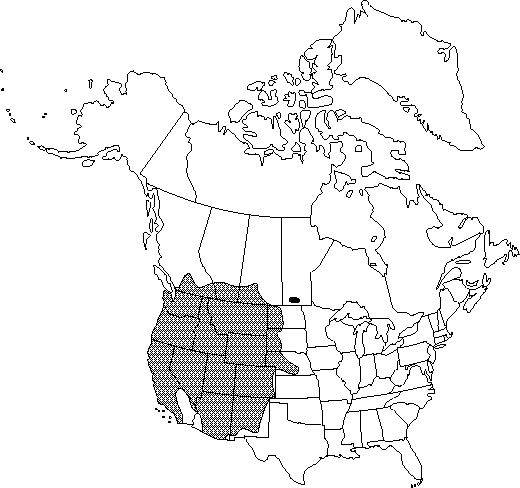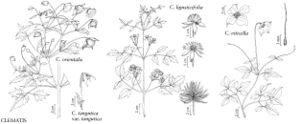Difference between revisions of "Clematis ligusticifolia"
in J. Torrey and A. Gray, Fl. N. Amer. 1: 9. 1838.
FNA>Volume Importer |
FNA>Volume Importer |
||
| Line 33: | Line 33: | ||
}}<!-- | }}<!-- | ||
| − | --><span class="statement" id="st- | + | --><span class="statement" id="st-undefined" data-properties=""><b>Stems </b>clambering or climbing, to 6(-20) m. <b>Leaf</b> blade pinnately 5-foliolate or 2-pinnate and 9-15-foliolate, somewhat succulent; leaflets lanceolate to broadly ovate, lobed or unlobed, (1-)3-9 × 0.9-7.2 cm, margins entire or variously toothed; surfaces abaxially glabrous or sparsely pilose or silky, especially on veins; ultimate venation obscure. <b>Inflorescences</b> axillary, usually 7-20(-65)-flowered compound cymes, often distinctly corymbiform, flowers crowded. <b>Flowers</b> unisexual; pedicel slender, 0.5-3 cm; sepals wide-spreading, not recurved, white to cream, obovate to oblanceolate, 6-10 mm, abaxially and adaxially pilose; stamens 25-50; staminodes absent or fewer than stamens; pistils 25-65. <b>Achenes</b> elliptic, 3-3.5 × ca. 1.5 mm, prominently rimmed, silky; beak 3-3.5 cm. <b>2n</b> = 16.</span><!-- |
-->{{Treatment/Body | -->{{Treatment/Body | ||
| Line 39: | Line 39: | ||
|habitat=Forest edges, woods, riparian deciduous woodlands, moist wooded draws, scrub, secondary sites derived from these, or clearings and pastures, usually near streams or on moist slopes | |habitat=Forest edges, woods, riparian deciduous woodlands, moist wooded draws, scrub, secondary sites derived from these, or clearings and pastures, usually near streams or on moist slopes | ||
|elevation=0-2600 m | |elevation=0-2600 m | ||
| − | |distribution=Alta.;B.C.;Man.;Sask.;Ariz.;Calif.;Colo.;Idaho;Mont.;Nebr.;Nev.;N.Mex.;N.Dak.;Oreg.;S.Dak.;Utah;Wash.;Wyo.;nw Mexico | + | |distribution=Alta.;B.C.;Man.;Sask.;Ariz.;Calif.;Colo.;Idaho;Mont.;Nebr.;Nev.;N.Mex.;N.Dak.;Oreg.;S.Dak.;Utah;Wash.;Wyo.;nw Mexico. |
|discussion=<p>Clematis ligusticifolia is the common virgin's-bower in the western United States and Canada. In California it might hybridize with C. lasiantha. In Mexico it is found only in the extreme north; it is probably related to the Mexican and Central American species, C.grossa Bentham.</p><!-- | |discussion=<p>Clematis ligusticifolia is the common virgin's-bower in the western United States and Canada. In California it might hybridize with C. lasiantha. In Mexico it is found only in the extreme north; it is probably related to the Mexican and Central American species, C.grossa Bentham.</p><!-- | ||
--><p>The name Clematis neomexicana has been applied to the populations with crenate leaflets in New Mexico and northern Chihuahua. This distinction is tenuous, however, given the wide variation present in leaflet margins within this and other species in Clematis subg. Clematis.</p><!-- | --><p>The name Clematis neomexicana has been applied to the populations with crenate leaflets in New Mexico and northern Chihuahua. This distinction is tenuous, however, given the wide variation present in leaflet margins within this and other species in Clematis subg. Clematis.</p><!-- | ||
| Line 62: | Line 62: | ||
|habitat=Forest edges, woods, riparian deciduous woodlands, moist wooded draws, scrub, secondary sites derived from these, or clearings and pastures, usually near streams or on moist slopes | |habitat=Forest edges, woods, riparian deciduous woodlands, moist wooded draws, scrub, secondary sites derived from these, or clearings and pastures, usually near streams or on moist slopes | ||
|elevation=0-2600 m | |elevation=0-2600 m | ||
| − | |distribution=Alta.;B.C.;Man.;Sask.;Ariz.;Calif.;Colo.;Idaho;Mont.;Nebr.;Nev.;N.Mex.;N.Dak.;Oreg.;S.Dak.;Utah;Wash.;Wyo.;nw Mexico | + | |distribution=Alta.;B.C.;Man.;Sask.;Ariz.;Calif.;Colo.;Idaho;Mont.;Nebr.;Nev.;N.Mex.;N.Dak.;Oreg.;S.Dak.;Utah;Wash.;Wyo.;nw Mexico. |
|reference=None | |reference=None | ||
|publication title=in J. Torrey and A. Gray, Fl. N. Amer. | |publication title=in J. Torrey and A. Gray, Fl. N. Amer. | ||
|publication year=1838 | |publication year=1838 | ||
|special status=Selected by author to be illustrated | |special status=Selected by author to be illustrated | ||
| − | |source xml=https://jpend@bitbucket.org/aafc-mbb/fna- | + | |source xml=https://jpend@bitbucket.org/aafc-mbb/fna-data-curation.git/src/9216fc802291cd3df363fd52122300479582ede7/coarse_grained_fna_xml/V3/V3_916.xml |
|genus=Clematis | |genus=Clematis | ||
|subgenus=Clematis subg. Clematis | |subgenus=Clematis subg. Clematis | ||
|species=Clematis ligusticifolia | |species=Clematis ligusticifolia | ||
| − | |||
| − | |||
| − | |||
| − | |||
| − | |||
| − | |||
| − | |||
| − | |||
| − | |||
| − | |||
| − | |||
| − | |||
| − | |||
| − | |||
| − | |||
| − | |||
| − | |||
| − | |||
| − | |||
| − | |||
| − | |||
| − | |||
| − | |||
| − | |||
| − | |||
| − | |||
| − | |||
| − | |||
| − | |||
| − | |||
| − | |||
| − | |||
| − | |||
| − | |||
| − | |||
}}<!-- | }}<!-- | ||
-->[[Category:Treatment]][[Category:Clematis subg. Clematis]] | -->[[Category:Treatment]][[Category:Clematis subg. Clematis]] | ||
Revision as of 14:53, 27 July 2019
Stems clambering or climbing, to 6(-20) m. Leaf blade pinnately 5-foliolate or 2-pinnate and 9-15-foliolate, somewhat succulent; leaflets lanceolate to broadly ovate, lobed or unlobed, (1-)3-9 × 0.9-7.2 cm, margins entire or variously toothed; surfaces abaxially glabrous or sparsely pilose or silky, especially on veins; ultimate venation obscure. Inflorescences axillary, usually 7-20(-65)-flowered compound cymes, often distinctly corymbiform, flowers crowded. Flowers unisexual; pedicel slender, 0.5-3 cm; sepals wide-spreading, not recurved, white to cream, obovate to oblanceolate, 6-10 mm, abaxially and adaxially pilose; stamens 25-50; staminodes absent or fewer than stamens; pistils 25-65. Achenes elliptic, 3-3.5 × ca. 1.5 mm, prominently rimmed, silky; beak 3-3.5 cm. 2n = 16.
Phenology: Flowering summer (Jun–Sep).
Habitat: Forest edges, woods, riparian deciduous woodlands, moist wooded draws, scrub, secondary sites derived from these, or clearings and pastures, usually near streams or on moist slopes
Elevation: 0-2600 m
Distribution

Alta., B.C., Man., Sask., Ariz., Calif., Colo., Idaho, Mont., Nebr., Nev., N.Mex., N.Dak., Oreg., S.Dak., Utah, Wash., Wyo., nw Mexico.
Discussion
Clematis ligusticifolia is the common virgin's-bower in the western United States and Canada. In California it might hybridize with C. lasiantha. In Mexico it is found only in the extreme north; it is probably related to the Mexican and Central American species, C.grossa Bentham.
The name Clematis neomexicana has been applied to the populations with crenate leaflets in New Mexico and northern Chihuahua. This distinction is tenuous, however, given the wide variation present in leaflet margins within this and other species in Clematis subg. Clematis.
Two varieties of Clematis ligusticifolia have been weakly distinguished based on the presence or absence of 2-pinnate leaves.
Infusions prepared from the plants of Clematis ligusticifolia were used medicinally by Native Americans as a wash for skin eruptions, a lotion for backaches or swollen limbs, and a lotion to protect one against witches; stems and leaves were chewed to treat colds and sore throats; decoctions of leaves were also used as a wash and for stomachaches and cramps; and lathers of leaves were used to treat boils on humans and on animals (D. E. Moerman 1986).
Selected References
None.
